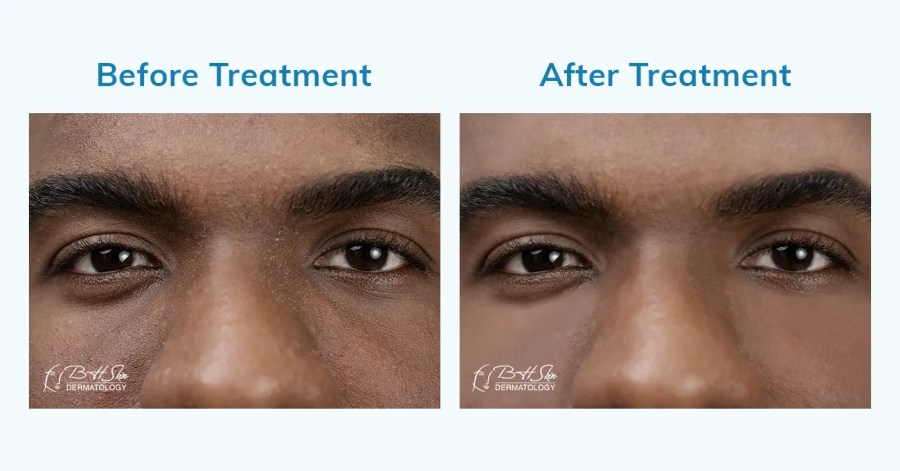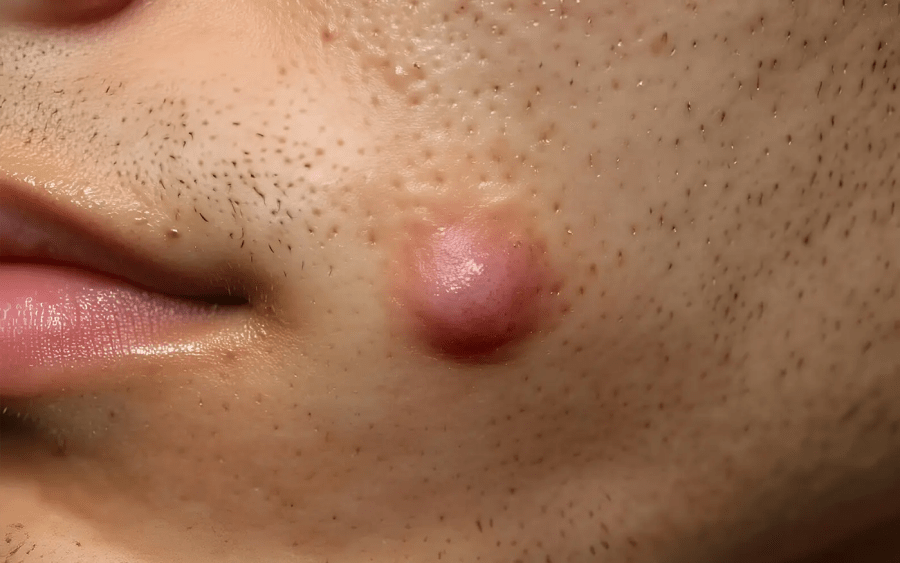
A Dermatologist Weighs In: Does Dermaplaning Help with Acne?
Contents
Having an acne breakout again? We feel you. This skin condition strikes without warning and often takes time to clear up, making most people feel like it’s a never-ending fight. So, it’s no surprise that many are willing to try the “latest” facial treatments promising healthier skin
One option that’s currently having its moment is dermaplaning. This treatment isn’t exactly new, but it has surged in popularity recently, owing to social media

What is dermaplaning? Who can perform this procedure? Do dermatologists recommend dermaplaning for acne? If you’d like to know more about this treatment but aren’t sure who to ask, you’re in the right place. This article answers these questions and more.
But first, you need to know…
What Is Acne?
Acne appears when pores get clogged with excess oil (sebum), dead skin cells, and debris. Pore blockage leads to the formation of a comedone, the earliest manifestation of acne.
Comedones are more commonly known as whiteheads or blackheads. Whiteheads develop from clogged pores that stay closed. Blackheads arise from clogged pores that remain open, letting their contents darken. Comedones are non-inflammatory types of acne.
When bacteria, especially Cutibacterium acnes, multiply in a clogged pore, the immune system responds by triggering the inflammation process. Comedones then become inflamed, forming red or pus-filled lesions that may be painful and warm to the touch.
What Is Dermaplaning?
Dermaplaning is a quick skin treatment that uses a sterile blade to gently dislodge dead skin cells and fine hair—also called “vellus hair”—from the face. Think of it as another skin resurfacing therapy, except it’s milder. During a dermaplaning procedure, the blade glides in a controlled fashion to remove fine facial hair and dead skin cells in the outer skin layer, called the “stratum corneum” or “skin barrier,” which protects underlying tissue.
The stratum corneum is also the target of microdermabrasion. However, this treatment exfoliates the skin by blasting fine crystals combined with suction, making it harsher than dermaplaning. Procedures like chemical peels, dermabrasion, and laser therapy reach deeper skin layers, creating more dramatic results but also carrying a greater risk of inflammation, infection, and scarring, especially if performed by inexperienced providers.
Compared to these alternatives, dermaplaning is relatively inexpensive since it requires simple tools. It also causes less inflammation, which may lower the risk of side effects, such as severe skin irritation or scarring.
Dermaplaning dates back to the 1970s and has been used to treat a wide range of skin concerns, including the following:
- Acne
- Acne scar formation
- Dull, dry skin
- Skin thickening from advanced rosacea
- Uneven skin tone
- Ingrown hair
This procedure also helps skincare products work better since removing built-up dead skin cells makes it easier for active ingredients to sink in.

For years, dermaplaning was mostly used in dermatology clinics to prep the skin for stronger treatments like chemical peels. It wasn’t widely known outside medical settings and was often overshadowed by trendier, more modern procedures like laser skin resurfacing. Today, it’s drawing renewed interest as people look for inexpensive, no-fuss alternatives to more aggressive skin therapies.
How Can Dermaplaning Help Acne?
Research on dermaplaning’s effects on acne is currently limited. However, its exfoliating action may help clear pimples by peeling off dead skin cells, clearing clogged pores, and enhancing the absorption of topical medications.
Fine facial hair can trap oil, dirt, and bacteria. Removal of this so-called “peach fuzz” helps reduce buildup that may contribute to acne.
What Are the Reported Benefits of Dermaplaning Treatment?
Again, there aren’t enough large-scale studies to substantiate the supposed benefits of dermaplaning. However, some reports suggest the procedure is gentle enough for sensitive skin, including in people on acne treatment. Unclogging pores also helps prevent whiteheads and blackheads from becoming inflamed.
Additionally, its effects are immediate. Comedones, peach fuzz, uneven skin tone, and skin texture issues like fine wrinkles, thickened skin (phymas), and shallow scars may appear visibly improved right after the procedure. By boosting the absorption of topical acne treatments and cosmeceuticals, dermaplaning may also increase the efficacy of any subsequent treatments.
What Are the Potential Risks of Dermaplaning?
This procedure isn’t suitable for inflamed acne, as it can aggravate the condition and increase the likelihood of scarring. It’s also ineffective as a standalone treatment for more severe skin lesions, such as hypertrophic scars (raised scars), stretch marks, coarse wrinkles, and spider veins.
Since it involves a sharp blade, improper technique, especially by unlicensed providers, can lead to bleeding, infection, or scar formation. Exfoliated skin is more prone to UV damage due to increased photosensitivity.
Because dermaplaning uses a pointed blade that can potentially nick the skin, certain conditions make the procedure unsafe. These contraindications include the following:
- Poor immunity
- Blood sugar issues
- Inability to stay still or cooperate during the treatment
- Local or widespread infection
- Metal allergy
- Open cuts or inflammation in the target area

The American Academy of Dermatology has not officially recommended dermaplaning as part of routine skin care or standard acne treatment. More research is needed to confirm its safety and effectiveness, which means it’s inherently risky. Still, if you’re considering having the treatment, it’s best to seek help from a board-certified dermatologist with vast experience in cosmetic skin procedures.
Who Is Qualified to Do Dermaplaning?
Ideally, dermaplaning should be performed by a board-certified dermatologist or any physician highly proficient in cosmetic skin treatments. Other trained professionals, including nurse practitioners, physician assistants, and aestheticians, may also perform this procedure. However, state regulations often mandate physician oversight during the treatment because of the risks associated with using a surgical blade.
What Can You Expect at Every Step of Your Dermaplaning Treatment Journey?
During your initial acne consultation, your dermatologist will take a complete medical history and perform a physical exam to assess your skin. They’ll educate you on the many in-office procedures that can help you deal with acne. If dermaplaning seems like a good fit, they’ll schedule your session and explain how to prepare for it.
Before the Treatment
There are no official guidelines for preparing for dermaplaning, and recommendations may vary between providers. However, common prep steps, similar to those for other minimally invasive cosmetic procedures, may include the following:
- Using sun protection
- Avoiding blood thinners (e.g., aspirin, vitamin E, fish oil)
- Skipping alcohol and smoking, which impair healing
- Taking antiviral medication if you’re prone to cold sores
- Using hydroquinone if you’re at risk for blotching
- Starting bromelain or arnica to reduce bruising
These steps can help minimize complications and promote faster skin recovery.
During the Treatment
You’ll be expected to arrive with your face washed and free of makeup. At the start of your session, the provider will thoroughly cleanse the target area. Using a sterile surgical blade, they will remove dead skin cells and peach fuzz carefully, avoiding your eyebrows and any sites with active acne. They will stretch your skin taut for safety. The specialist will pass the blade once or twice per area.
Afterward, a gentle toner, moisturizer, and broad-spectrum sunscreen will be applied to the treated area to protect it and help with its recovery. No anesthesia is necessary, as the procedure is painless when performed correctly. Sessions usually take less than an hour, depending on the severity of your skin condition.

After the Treatment
Dermaplaning typically causes minimal inflammation, requiring little to no downtime. Aftercare recommendations can vary between providers, but your dermatologist may advise the following:
- Sun protection
- Gentle cleansing twice daily
- Regular moisturizing
- Ice packs to ease swelling, pain, or redness
- Sleeping with your head raised to reduce puffiness
- Continuing bromelain or arnica to prevent bruising
These steps can help minimize discomfort and reduce the risk of complications. Contact your doctor if you experience significant pain, bruising, bleeding, unusual discoloration, or any signs of infection, such as discharge or fever.
What’s the Timeline for Dermaplaning Results?
As mentioned, dermaplaning yields results right away. However, since it’s a superficial treatment, and the skin renews itself every month, its effects are short-lived.
While more aggressive procedures like microneedling and laser resurfacing can stimulate collagen production and lead to skin tightening, there’s limited evidence that dermaplaning offers similar long-term effects beneath the surface. Most practitioners suggest getting it done once a month for the best outcome.
Professional Dermaplaning as an Acne Treatment Option
Dermaplaning is a decades-old procedure that has recently gone viral for its supposed ability to restore skin health gently as opposed to other skin resurfacing methods. A surgical blade is used to shave off dead skin cells and fine facial hair carefully. This technique has been traditionally used for mild acne, uneven skin tone, shallow acne scars, ingrown hair, and other superficial skin problems.
Proponents hail dermaplaning as it is well-tolerated by people with sensitive skin, produces immediate results, and enhances the absorption of topical medications. However, since the treatment requires the use of a sharp blade, complications like bleeding, scar formation, and infection can develop.
Despite the online hype, the fact remains that evidence is still insufficient to recommend dermaplaning as part of a standard skincare routine or acne regimen. Since there aren’t official guidelines for how to perform this treatment, outcomes can differ widely based on skin type and condition.
That said, if you’re considering having this procedure, it’s wise to be cautious. Entrust professional dermaplaning to no less than the right specialist. Always choose a board-certified dermatologist to ensure that your acne treatment is safe and effective.
Finding Radiant Skin Elusive? Turn to LA’s Top Acne Experts
Acne can be frustrating to treat, especially if you have sensitive skin. Dermaplaning can get rid of whiteheads and blackheads easily, but is it enough for a severe acne breakout?
At BHSkin Dermatology, our acne specialists are some of the best in the Golden State. We provide a wide array of effective acne treatments for patients in the Los Angeles area. Visit our Glendale or Encino clinic or use our virtual platform for your initial consultation.
Don’t wait forever to beat acne scarring and get smoother skin. Book your appointment today!
References:
- Chang, D. K., Savetsky, I. L., Avashia, Y. J., & Rohrich, R. J. (2020). A Safe, Modern Treatment of Rhinophyma: The 5-Step Technique. Plastic and Reconstructive Surgery. 8(6), e2620. https://journals.lww.com/prsgo/fulltext/2020/06000/a_safe,_modern_treatment_of_rhinophyma__the_5_step.17.aspx
- Goh, C., Cheng, C., Agak, G., Zaenglein, A. L., Graber, E. M., Thiboutot, D. M., & Kim, J. (2019). Chapter 78: Acne Vulgaris. Fitzpatrick’s Dermatology, 9th ed. https://accessmedicine.mhmedical.com/content.aspx?bookid=2570§ionid=210419885
- Gold, M. H., Andriessen, A., Goldberg, D. J., Grover, K. V., Hu, S., Lorenc, Z. P., Mandy, S. H., & Vega, J. H. (2020). Pre/Post-Procedure Measures for Minimally Invasive, Non-energy Aesthetic Treatments: A Survey. Journal of Cosmetic Dermatology. 19(7), 1587–1592. https://onlinelibrary.wiley.com/doi/abs/10.1111/jocd.13460
- Mauricio, T. (2018). Combining Hydradermabrasion with Aesthetic Treatments. https://rocol.com.co/wp-content/uploads/2021/11/1099_HF-White-Paper_7-11-18.pdf
- Pryor, L., Gordon, C. R., Swanson, E. W., Reish, R. G., Horton-Beeman, K., & Cohen, S. R. (2011). Dermaplaning, Topical Oxygen, and Photodynamic Therapy: A Systematic Review of the Literature. Aesthetic Plastic Surgery. 35(6), 1151–1159. https://pubmed.ncbi.nlm.nih.gov/21533984/
- Tijani, A. O., Frempong, D., Kaur, J., Sergent, S., Shaw, K., Lessaint, R., Al Shawi, M., Verana, G., & Puri, A. (2023). Dermaplaning for Transdermal Drug Permeation Enhancement: A Qualitative and Quantitative Assessment. AAPS PharmSciTech. 24(2), 54. https://link.springer.com/article/10.1208/s12249-023-02505-y
- Townsend, R. (2017). The Use of Advance Dermaplaning in Clinical Skin Care and Treatment. Clinical Dermatology Research. 2, 2. https://www.semanticscholar.org/paper/The-Use-of-Advance-Dermaplaning-in-Clinical-Skin-Townsend/8acb9285b0875542289a18e4d66dd1fdf047f48c
Get superior skincare from LA's finest dermatologists
Book the type of an appointment that suits you best.





